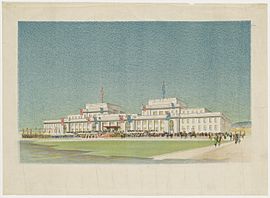Commonwealth Heritage List facts for kids

A picture from the opening of the first Commonwealth Parliament at Old Parliament House on 9 May 1927.
|
|
| Type | A list of important natural, historic, and Indigenous places owned by the Australian Government |
|---|---|
| Country | Australia |
| Years | 2003 – present |
| Came after | Register of the National Estate |
| Made by | Australian Government through the Australian Heritage Council |
The Commonwealth Heritage List is a special list created in 2003. It names places that are important to Australia's history or nature. These places are owned or controlled by the Australian government. This includes land or water directly owned by the government.
Places on this list must be important for Australia's natural or historic past. This also includes places that are very important to Indigenous Australians. These special places are protected by a law called the Environment Protection and Biodiversity Conservation Act 1999.
The Commonwealth Heritage List and the Australian National Heritage List replaced an older list in 2003. The National Heritage List includes places that are super important to the whole country. The Commonwealth Heritage List focuses on heritage places that the Australian government owns or controls.
Places on this list can be many different things. They include old telegraph stations, defence sites, and places where new arrivals to Australia first stayed. Lighthouses, national buildings like Parliament House, and even islands or marine areas can also be on the list.
You can find all places on this list in the online Australian Heritage Database. This database also shows other important Australian and world heritage sites.
History of the List
In 2004, the Australian Government started a new way to protect Australia’s special heritage places. They changed a law called the Environment Protection and Biodiversity Conservation Act 1999. This law now clearly protects cultural heritage.
They also created two new lists: the Australian National Heritage List and the Commonwealth Heritage List. A group called the Australian Heritage Council was also set up. The older list, the Register of the National Estate, was kept but no longer had legal power.
The National Heritage List was made for a small number of places that are extremely important to Australia.
Why Places Are Chosen
A place can be added to the Commonwealth Heritage List if it meets certain important reasons. Here are some of them:
- History and Nature: The place is very important to Australia's natural or cultural history.
- Rare or Unique: It shows something uncommon, rare, or endangered about Australia's past or nature.
- Learning Opportunity: The place could help us learn more about Australia's natural or cultural history.
- Good Examples: It is a great example of a type of natural or cultural place in Australia.
- Beauty and Design: People or groups value the place for its beauty or special design.
- Clever Creations: It shows a high level of creative or technical skill from a certain time.
- Community Connection: The place has a strong or special link to a community or cultural group for social, cultural, or spiritual reasons.
- Important People: It is strongly connected to the life or work of an important person or group in Australia's history.
- Indigenous Traditions: The place is important as part of Indigenous traditions.
Where Are These Places?
As of April 30, 2020, the Commonwealth Heritage List had 388 heritage places. Here's how they are spread out across Australia:
| State or Territory | Number of Places | List of Places |
|---|---|---|
| Australian Capital Territory | 82 | |
| New South Wales | 130 | |
| Northern Territory | 12 | |
| Queensland | 31 | List for Queensland |
| South Australia | 11 | |
| Tasmania | 19 | |
| Victoria | 40 | |
| Western Australia | 19 | List for Western Australia |
| External territories | 43 | |
| Overseas | 2 |

